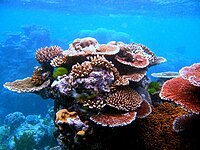
Photo from wikipedia
Abstract Patterns of movement of marine species can reflect strategies of reproduction and dispersal, species' interactions, trophodynamics, and susceptibility to change, and thus critically inform how we manage populations and… Click to show full abstract
Abstract Patterns of movement of marine species can reflect strategies of reproduction and dispersal, species' interactions, trophodynamics, and susceptibility to change, and thus critically inform how we manage populations and ecosystems. On coral reefs, the density and diversity of metazoan taxa are greatest in dead coral and rubble, which are suggested to fuel food webs from the bottom up. Yet, biomass and secondary productivity in rubble is predominantly available in some of the smallest individuals, limiting how accessible this energy is to higher trophic levels. We address the bioavailability of motile coral reef cryptofauna based on small‐scale patterns of emigration in rubble. We deployed modified RUbble Biodiversity Samplers (RUBS) and emergence traps in a shallow rubble patch at Heron Island, Great Barrier Reef, to detect community‐level differences in the directional influx of motile cryptofauna under five habitat accessibility regimes. The mean density (0.13–4.5 ind cm−3) and biomass (0.14–5.2 mg cm−3) of cryptofauna were high and varied depending on microhabitat accessibility. Emergent zooplankton represented a distinct community (dominated by the Appendicularia and Calanoida) with the lowest density and biomass, indicating constraints on nocturnal resource availability. Mean cryptofauna density and biomass were greatest when interstitial access within rubble was blocked, driven by the rapid proliferation of small harpacticoid copepods from the rubble surface, leading to trophic simplification. Individuals with high biomass (e.g., decapods, gobies, and echinoderms) were greatest when interstitial access within rubble was unrestricted. Treatments with a closed rubble surface did not differ from those completely open, suggesting that top‐down predation does not diminish rubble‐derived resources. Our results show that conspecific cues and species' interactions (e.g., competition and predation) within rubble are most critical in shaping ecological outcomes within the cryptobiome. These findings have implications for prey accessibility through trophic and community size structuring in rubble, which may become increasingly relevant as benthic reef complexity shifts in the Anthropocene.
Journal Title: Ecology and Evolution
Year Published: 2023
Link to full text (if available)
Share on Social Media: Sign Up to like & get
recommendations!